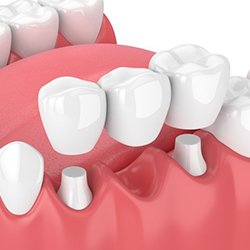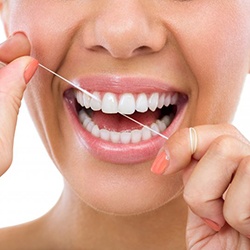Dental Bridges – Assonet, MA
Easy, Effective Tooth Replacement

With many options available to replace missing teeth, more and more patients are choosing to receive dental bridges rather than dentures, and it’s not hard to see why. At Woodside Dental Care, we offer quality dental bridges for our Assonet, MA dentistry patients made from materials that greatly resemble natural tooth enamel, both in the way they look and feel. We look forward to helping you rebuild your smile with dental bridges in Assonet!
Why Choose Woodside Dental Care for Dental Bridges?
- Able to Replace Several Consecutive Missing Teeth
- Each Restoration Custom-Made to Fit Your Smile
- Made of Metal-Free Dental Porcelain
What Are Dental Bridges?

A dental bridge is a customized restorative treatment used to replace up to three missing teeth in a row. Dental crowns are placed on the remaining teeth at either end of the space in your smile, and artificial teeth known as pontics literally bridge the gap. While pontics are available in several materials, we typically use dental porcelain due to its amazing ability to mimic the enamel of your surrounding teeth, making it appear like part of the smile you were born with.
Benefits of Dental Bridges

Bridges offer an easy, quick, and cost-effective way to replace missing teeth in Assonet. Unlike dental implants, bridges can be used even when you’ve undergone bone loss without resorting to bone grafting surgery.
With a dental bridge, you’ll once again be able to speak clearly and enjoy a variety of foods that were difficult to chew with missing teeth. Bridges maintain the shape of your facial muscles and preventing your remaining teeth from drifting out of place. Neglecting to replace missing teeth often results in bite changes that can increase your risk of gum disease. Luckily, bridges significantly reduce this risk.
The Process of Getting a Dental Bridge

During your first of two appointments, Dr. Derek Cornetta prepares your abutment teeth, which are the teeth that receive the crowns and anchor your bridge. This step entails removing an ultra-thin sliver of enamel from the affected teeth and then taking impressions of that area of your mouth. Once we send those impressions to the dental lab, they will begin crafting your bridge to our exact specifications. In the meantime, we’ll provide you with a temporary bridge to protect your gums and teeth.
A few weeks later, we’ll remove your temporary and place your permanent restoration. We’ll also provide you with guidelines on maximizing your bridge’s lifespan. With proper care, it could be more than a decade before you need a replacement!
Caring for Your Dental Bridge

Keeping your teeth strong and healthy is important because the success of your bridge depends on the health of the natural teeth supporting it. We suggest brushing twice a day and flossing at least once. Be sure to thread the floss underneath your pontics to clean leftover food particles and plaque from the area. It’s also imperative that you come in for regular checkups and cleanings. This allows us to treat oral health problems before they become serious and potentially damage your bridge.
To learn more about dental bridges in Assonet and how they can benefit your smile, give us a call today. The team here at Woodman Dental Care looks forward to improving your smile!
Dental Bridges FAQs
Is a Partial Denture the Same as a Bridge?
Partial dentures are sometimes called “removable bridges,” but this is misleading, as they are not the same as dental bridges. A bridge is designed to stay in place for many years, and it can only be removed by a dental professional. However, partial dentures are removable and can be removed by the patient at any time. The other main difference is that bridges are only able to replace missing teeth if they are consecutive, while partials can replace teeth that are at various points along an arch. During your consultation with us, we will discuss your options to determine which can best meet your needs.
How Many Teeth Can a Dental Bridge Replace?
Depending on your needs, a dental bridge can replace anywhere from one to four missing teeth in a row. However, in the majority of cases, bridges are used to replace just one or two missing teeth. The longer that the bridge extends, the less stable it becomes, so it is risky to have a bridge replace three or more teeth. One exception is implant bridges, as they can lower this risk.
Do Dental Bridges Look Natural?
Our dental bridges are made from porcelain, so they are color-matched to the rest of your teeth. Porcelain looks very similar to tooth enamel, and it even reflects light similarly. Once placed, your dental bridge should blend in with the rest of your smile very well. Dental bridges are adhered to the adjacent teeth using dental cement, so you don’t need to worry about your replacement tooth shifting around and popping out as you might with ill-fitting dentures.
How Soon Can You Get a Bridge After a Tooth Extraction?
After you have a tooth extracted, your gums and jawbone need to take the time to heal. If a bridge is placed before then, it might not end up fitting as it should. The duration of this healing process can vary from patient to patient, but it usually takes between eight and twelve weeks to complete. During your visit with us, we can review your situation and give you an estimated timeline for getting your bridge.
